PDF file - Community Services Center
PDF file - Community Services Center
PDF file - Community Services Center
You also want an ePaper? Increase the reach of your titles
YUMPU automatically turns print PDFs into web optimized ePapers that Google loves.
BooK rEviEW<br />
The Buddha in<br />
the Attic<br />
by Julie Otsuka<br />
published in 2011<br />
published by alfred a. knopf<br />
Isbn: 978-0-307-70046-9<br />
tEXt: KAtH LIu<br />
What possesses someone<br />
to pack up everything<br />
they own and move to<br />
a country they have<br />
never been to before, especially when<br />
they don't speak very much of the<br />
language nor understand very much<br />
of the culture of their destination<br />
country? Necessity? A dream of<br />
a better life? Wanderlust? Love?<br />
For the group of young Japanese<br />
women in this novel it was a bit of<br />
everything. As mail-order brides,<br />
they were to be married to men<br />
whom they had only heard about<br />
through written letters and a single<br />
photograph. Leaving their lives,<br />
their families, their culture and their<br />
comfort zone, they set out across<br />
the ocean for America. When they<br />
arrived the reality that faced them<br />
was devastatingly different to their<br />
hopes and expectations.<br />
T h r o u g h f i r s t p e r s o n p l u r a l<br />
narration, Otsuka presents the<br />
collective experiences of these<br />
women, divided thematically by<br />
significant events – from their first<br />
night as wives to childbirth to<br />
their removal from the towns and<br />
cities along the Pacific coast during<br />
World War Two. As a result of<br />
this narrative style and thematic<br />
organization there isn't a traditional<br />
plot with a beginning, middle and<br />
end. Rather the experience of<br />
reading the stories of many comes<br />
to be almost like a meditation on<br />
lives past. The choice to present<br />
this material in this way is a wise<br />
one, I think, as to do anything other<br />
than present the simple facts could<br />
create a potential emotional overload<br />
for the reader. This is not only<br />
because of the number of different<br />
perspectives and stories but also<br />
because of the confronting nature of<br />
the content within.<br />
I remember very clearly the first<br />
time I discovered that Japanese<br />
Americans and Canadians had been<br />
removed from their homes and<br />
livelihoods during the Second World<br />
War when I read Obasan by Joy<br />
Kogawa for a postgraduate trauma<br />
literature paper. I'd no idea that this<br />
kind of thing had happened and to<br />
be honest, I was shocked by what I<br />
learned. It hadn't mattered if these<br />
people had lived there half of their<br />
lives, or if they had been born there<br />
and were therefore citizens – in the<br />
wake of the Japanese attack on<br />
Pearl Harbor, President Roosevelt<br />
authorized the exclusion of all people<br />
of Japanese ancestry from the Pacific<br />
coastline and housed them in war<br />
interment camps inland. Like I said –<br />
it's confronting stuff. But let's forget<br />
for a moment all of the why's and<br />
the wherefores of this decision. Let's<br />
hold off on the pointing of fingers<br />
and the placement of blame and guilt<br />
and focus on what it is that Otsuka<br />
is telling us to do – to listen to the<br />
voices that couldn't be heard back<br />
then.<br />
These voices are not only of the<br />
Japanese who were interred but also<br />
of their neighbors who were very<br />
much affected by their removal.<br />
The last chapter is written from the<br />
perspective of these neighbors which<br />
shows that at first they were worried,<br />
upset and guilty about the way the<br />
Japanese had been treated. But as<br />
time passes and new stores open<br />
in place of Mr Harada's grocery<br />
or the Imanashi Transfer, and the<br />
Instructions to All Persons of<br />
Japanese Ancestry notices fade and<br />
blow away with a stronger breeze<br />
than usual, so too do the feelings and<br />
the memories. People move on. It<br />
seems cold but it is after all human<br />
nature to let go of things that do<br />
not continue to affect you on a daily<br />
basis. Especially when your country<br />
is about to become involved in the<br />
worst war this world has ever seen.<br />
Otsuka's novella is an attempt<br />
to reestablish these lost stories<br />
and assure their place within the<br />
narrative of America's history. As<br />
the title suggests, it’s time for it<br />
to be taken down out of the attic,<br />
dusted off and examined, honestly<br />
and with an open heart and mind.<br />
As with many novels that deal with<br />
subjects of uncomfortable moments<br />
in history this is not an uplifting<br />
read. It presents us, the present day<br />
reader, with a slice of a time gone by<br />
told through the imagined voices of<br />
those who experienced it. It's a tale<br />
of belonging, of inner strength, of<br />
cultural struggles and of real life. It's<br />
a timely reminder of how far we have<br />
come in this world, but also, perhaps,<br />
how much further we have yet to go.<br />
Kath Liu is an<br />
avid reader and a<br />
founding member<br />
of the CSC Book<br />
Club who believes<br />
happiness is a good book, good<br />
coffee and good friends.<br />
Like books? Check this out:<br />
http://kathmeista.blogspot.com/<br />
24<br />
february 2012 www.communitycenter.org.tw


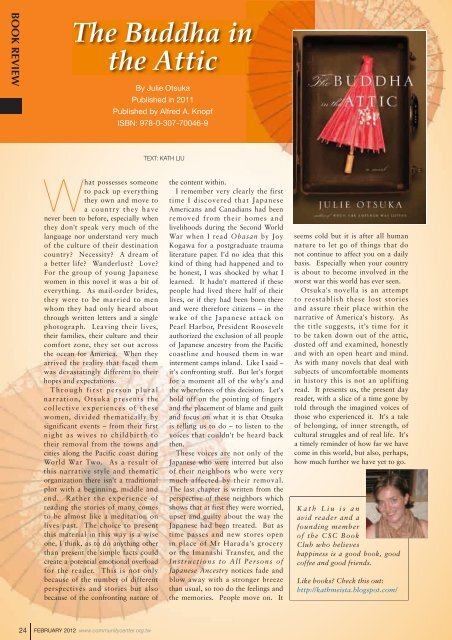
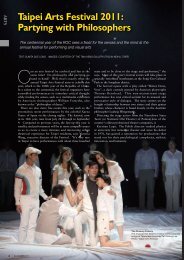
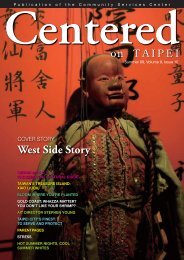



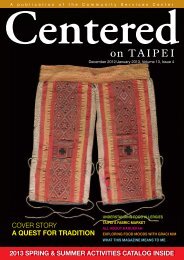

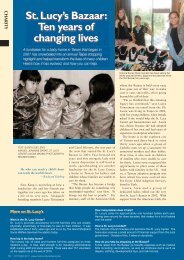

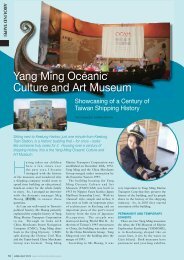
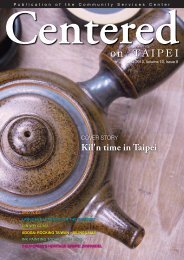


![Rice 米 [mi] - Community Services Center](https://img.yumpu.com/22967832/1/184x260/rice-mi-community-services-center.jpg?quality=85)